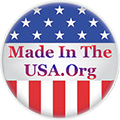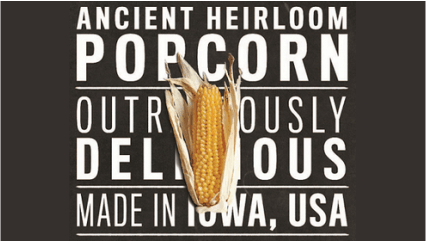One of the products Tiny But Mighty sells is Made in the USA Popcorn. A more complete list of their products is provided by Made in America Secrets, to review their list click here.
For more information about Tiny But Mighty and its Made in America products see the following:
Gene and Lynn Mealhow, and their sons, have been producing Tiny But Mighty Popcorn? since the late 1990s. A third-generation family farmer and soil consultant by profession, Gene continues to consult with farmers regarding sustainable practices. He bought the popcorn business from Richard Kelty, whose family had farmed in Urbana, IA for several generations.
In the 1980s, when his father and uncle left farming, Gene started to look at the whole picture involving groundwater and chemicals. He joined a soil consulting firm, which advised farmers about soil nutrients and seed selection. One of Gene's first customers in the early 1990s was Richard Kelty, who brought Mealhow in to reduce his waste and increase his yield. The popcorn stalks were falling down and producing only 600 lbs per acre, which was not commercially viable. One of the early challenges was getting the three-inch long ears to fill to the tip.
Gene's first reaction when he encountered the tiny corn kernels was What in the world is this stuff? He began consulting with experts from around the United States, and discovered that the K&K kernel is most likely a variety of flint corn. The Kelty and Kramer families either found it growing in Iowa when they settled here in the 1850s, or they traded for it with local Indians. It may have even originated in the western states.
According to Richard Kelty, original owner of the company, his great, great, great-grandfather, Samuel Kelty, settled just northwest of what is now Cedar Rapids in the 1850s. While no one in his family knows exactly where the seed came from, they believe it came from Indian neighbors. When Richard Kelty returned home from the army in the mid-1970s, he found the last remaining seed in a fruit jar. He popped some and planted the rest?and a new business was born.
What makes Tiny But Mighty popcorn unique, besides its tiny kernels and disintegrating hulls, is that it is open pollinated. A 128-day corn, TBM is also difficult to raise, process, and keep its integrity. Gene consulted with a popcorn breeder from Idaho, who said TBM was a rare variety. Because it is hard to breed, most people in the popcorn industry wanted nothing to do with it.
For the Mealhows, popcorn is not just a business. It's their passion, and Tiny But Mighty Popcorn? is a product they do not want to die. One of their biggest pleasures is meeting customers, who range from friends to people throughout the United States. In fact, Gene doesn't like to use the word customer, instead, he builds friendships with people who enjoy his product. At a recent trade show in Chicago, Mealhow was thrilled to have a mother say to her kids, This is a real farmer, and he's from Iowa.
For more information about Tiny But Mighty and its Made in America products see the following:
Gene and Lynn Mealhow, and their sons, have been producing Tiny But Mighty Popcorn? since the late 1990s. A third-generation family farmer and soil consultant by profession, Gene continues to consult with farmers regarding sustainable practices. He bought the popcorn business from Richard Kelty, whose family had farmed in Urbana, IA for several generations.
In the 1980s, when his father and uncle left farming, Gene started to look at the whole picture involving groundwater and chemicals. He joined a soil consulting firm, which advised farmers about soil nutrients and seed selection. One of Gene's first customers in the early 1990s was Richard Kelty, who brought Mealhow in to reduce his waste and increase his yield. The popcorn stalks were falling down and producing only 600 lbs per acre, which was not commercially viable. One of the early challenges was getting the three-inch long ears to fill to the tip.
Gene's first reaction when he encountered the tiny corn kernels was What in the world is this stuff? He began consulting with experts from around the United States, and discovered that the K&K kernel is most likely a variety of flint corn. The Kelty and Kramer families either found it growing in Iowa when they settled here in the 1850s, or they traded for it with local Indians. It may have even originated in the western states.
According to Richard Kelty, original owner of the company, his great, great, great-grandfather, Samuel Kelty, settled just northwest of what is now Cedar Rapids in the 1850s. While no one in his family knows exactly where the seed came from, they believe it came from Indian neighbors. When Richard Kelty returned home from the army in the mid-1970s, he found the last remaining seed in a fruit jar. He popped some and planted the rest?and a new business was born.
What makes Tiny But Mighty popcorn unique, besides its tiny kernels and disintegrating hulls, is that it is open pollinated. A 128-day corn, TBM is also difficult to raise, process, and keep its integrity. Gene consulted with a popcorn breeder from Idaho, who said TBM was a rare variety. Because it is hard to breed, most people in the popcorn industry wanted nothing to do with it.
For the Mealhows, popcorn is not just a business. It's their passion, and Tiny But Mighty Popcorn? is a product they do not want to die. One of their biggest pleasures is meeting customers, who range from friends to people throughout the United States. In fact, Gene doesn't like to use the word customer, instead, he builds friendships with people who enjoy his product. At a recent trade show in Chicago, Mealhow was thrilled to have a mother say to her kids, This is a real farmer, and he's from Iowa.

